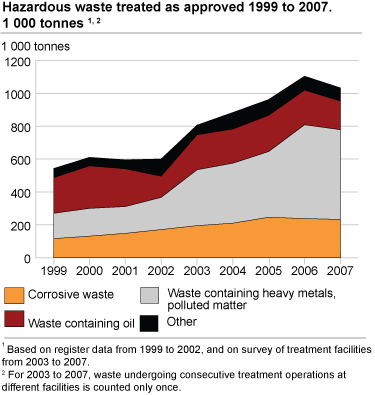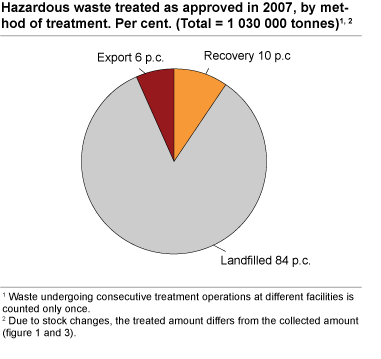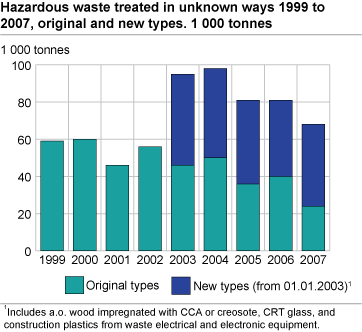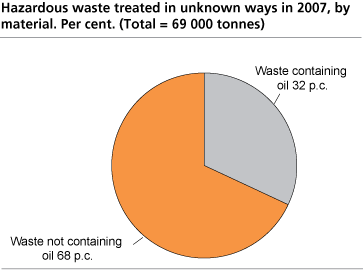Content
Published:
This is an archived release.
Less hazardous waste
A total of 1 030 000 tonnes of hazardous waste were treated as approved in 2007, after a 6 per cent decline from the peak amount in the previous year. The quantity of hazardous waste handled by unknown methods also declined, by 15 per cent from the previous year.
Approved plants treated 1 030 000 tonnes of hazardous waste in 2007. This is 70 000 tonnes, or 6 per cent, less than the previous year. There was a fall in all material categories, but most in corrosive waste by 17 per cent.
Waste containing heavy metals and polluted matter was the dominating material category in 2007, making up 53 per cent of the waste. Oil-containing waste and corrosive waste were also significant waste categories, with 23 and 17 per cent respectively. The manufacturing industries generated 55 per cent of the waste with known source of origin.
Unclear whether this is a new trend
Overall, for the period 1999 to 2007 there was a growth in the recorded amount of hazardous waste of 90 per cent. It is therefore yet to be concluded whether last year’s decline is the start of a new downward tendency, or a result of random variation. Significant parts of the growth from 1999 to 2007 are assumed to result from an improved data basis, which means that the real growth in waste amounts may be considerably less than the statistics show.
The main part is treated in Norway
In 2007, 87 per cent of the hazardous waste was disposed of in Norway, while slightly less than 2 per cent was exported for disposal. The amount being recovered in Norway constituted 7 per cent, while slightly less than 5 per cent was exported for recovery. The recycled amount increased from 2003 to 2007, while the energy recovered amount declined slightly. Overall, the recovered amount increased slightly from 2003 to 2007.
Less was handled in unknown ways
In 2007, 69 000 tonnes of hazardous waste were handled in unknown ways, according to estimates by Statistics Norway. This is 15 per cent down from 2006, and 28 per cent less than in 2003. Between 2002 and 2003, the list of hazardous waste was extended to include impregnated wood and plastics containing brominated flame retardants, among others. This explains the increase from 2002 to 2003. Excluding these new types of hazardous waste, the amount of hazardous waste handled in unknown ways decreased by 59 per cent from 1999 to 2007. Parts of the amount being handled in unknown ways may be included in the 1 030 000 tonnes of hazardous waste that was treated as approved.
Half the amount in 1999
Oil-containing hazardous waste made up 22 000 tonnes in 2007, which is half the amount in 1999. The amount of impregnated wood waste comprised about 50 000 tonnes, of which about 75 per cent was handled in unknown ways. The main part was impregnated with creosote, and is assumed to be subject to secondary use in private gardens, pathways, etc. Waste from PCB-containing windows is at present properly taken care of, and practically no such waste was handled in unknown ways in 2007.
|
Hazardous waste contains substances that can cause harm to humans and the environment. There are therefore strict regulations on handling, treating and exporting such waste. Some waste types are not covered by Statistics Norway’s estimates on hazardous waste being treated in unknown ways. Therefore, the real amount of hazardous waste going to unknown ways of handling may have been somewhat higher than estimated by Statistics Norway. |
Post revision of the reference years 2003 to 2006A post revision of basic data has increased the annual amount of hazardous waste for the period 2003 to 2006 by 4 to 9 per cent, compared to the previous release of statistics on hazardous waste. |
Tables:
- Table 1 Hazardous waste handled as approved in 1999 to 2007, original and new types. 1 000 tonnes
- Table 2 Hazardous waste treated as approved 1999 to 2007, by material. 1 000 tonnes.
- Table 3 Hazardous waste to unknown handling 1999 to 2007, original and new types. 1 000 tonnes
- Table 4 Hazardous waste to unknown handling 1999 to 2007, by material. 1 000 tonnes
- Table 5 Hazardous waste treated as approved 2003 to 2007, by method of treatment. 1 000 tonnes
- Table 6 Hazardous waste treated as approved 1999 to 2007, by source. 1 000 tonnes
Additional information
Approved treatment as applied in this article includes only hazardous waste generated in Norway (export is therefore included, while import is excluded).
Contact
-
Gisle Berge
E-mail: gisle.berge@ssb.no
tel.: (+47) 48 12 19 97
-
Terje Lorentzen Landsem
E-mail: terje.landsem@ssb.no
tel.: (+47) 98 84 31 39




